The Measure of a Master Swordsman
Journal of Western Martial Art
January 2005
by David M. Cvet
In contemplating the creatures illustrated by Fiore dei Liberi, illustrates an element of the medieval mind which reveals an innate allegorical interpretation and symbolism of beasts, stemming from their thought that the significance of each of the beasts illustrated, being far greater than the physical beast itself could aptly represent the master swordsman's most important warrior attributes. Learning the art in the 21st century, one must be tempered with the context of the medieval period to fully appreciate the art, in which bestiary played a significant role in the psyche of the medieval individual. Medieval bestiary, both real and imaginary beasts were originally derived from Physiologus ("Naturalist"), an anonymous text originally written sometime during the 2nd century after Christ, possibly in the great city of Alexandria. The insertion of bestiary over the centuries had left an indelible imprint on the medieval individual including Liberi, resulting in a metaphysical application of bestiary to the art of combat.
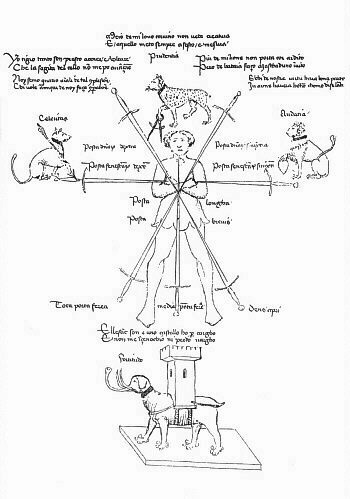 |
| A sample image called "sette spada" or "seven swords" from the treatise entitled "Flos Duellatorum" by Fiore dei Liberi, 1350 |
The image which graces this article with a reproduction on the left was extracted from a treatise composed by swordsmaster Fiore dei Liberi while in the court of the Marquise of Ferrara, in the year 1410. Written in an Italian dialect known as "Friuli", the treatise is entitled "Flos Duellatorum" or the "Flower of the Duel". There are three known versions of Liberi's treatises, and this particular image on the cover originates from a collection commonly known as the "Pisani Dossi", from a publication of a facsimile by Francesco Novati in 1902. The other two versions include "The Gettys" and "The Morgan", both held by museums in the United States.
The illustration on the left is referred to as "sette spada" or seven swords and depicts a figure of a man with seven swords centred on the body surrounded with four stylized animals or "beasts". The genius in Liberi is revealed in this single illustration which effectively encapsulates the entire art, both armed and unarmed fighting styles in terms that communicate the technical or the physical, and the intellectual or meta-physical attributes of combat. At first glance, each of the sword angles illustrated describe a path of one of seven possible offensive strikes, the six cuts and the thrust, all of which can be applied to most weapons including dagger. Positioned with the angles depicted are the written text referring to the posta, or guard positions illustrating the optimal offensive strategy from that particular guard position. It cleverly describes how a guard position can offer both a defensive posture and an offensive posture in the same instant. Beyond this level of interpretation, one can infer the most effective guard positions against opposing guard positions, a thread that surfaces numerous occasions in the treatise.
The technical attributes of fighting must be balanced with the meta-physical attributes represented in the above illustration as animal figures. Each animal figure and its relative position with respect to the figure of the man, refers to a particular attribute or trait of a fighter. Note that each of the animals illustrated are wearing a golden collar (gold in the original manuscript) which identifies the master in the illustrations of the plays described later in Liberi's manuscript. This implies that these attributes are possessed by the master swordsman and therefore, implies that these are master attributes or traits. It is critical that these attributes are emphasized during training and are important attributes that must be mastered in all fighters in order to achieve the level of skill and capabilities of a competent fighter.
The illustration also suggests that a good and honorable fighter is one who not only possesses these attributes, but is one who measures them in order to strike an optimal balance between them as well as balancing these meta-physical attributes with the technical skills which would result in offering the fighter improved probabilities of success in any engagement. Proceeding clockwise from the figure of the lynx, a more detailed examination of the animal figures follow.
The Lynx
"Meio de mi'louo ceruino non uede creatura
E aquello meto sempre a sesto e mesura
Prudentia."
"No other creature is able to look so clearly as me, the lynx
and continuously by that method of the compass and measure prudence."
The image of the lynx holding what appears to be a compass (a tool for determining the measure between two points) represents one of the four key attributes of a fighter, that being the ability to assess the actions continuously, making adjustments in response to the actions taken by the opponent and using this assessment, fight with prudence, measure and foresight to enhance one's success. The positioning of the lynx above the head of the figure of the man emphasizes the meta-physical and intellectual aspects of a fighter's ability through which judgment influences the measure which in turn maintains optimal distance (the sextant) and tactics. It is the result of good judgment that the fighter is able to anticipate the opponent's next move ensuring that the fighter will be in an optimal position in order to react to the offensive strike with speed and confidence with what might appear as uncanny ability to "foretell the future". This can only occur as a result of the fighter's ability to control the engagement through sound judgment and prudence, and therefore, being where the sword is not, ensuring the fighter a distinct advantage.
Judgment is a critical skill in fighting necessary to increase one's survival, however, in order for this to work it must be in concert with the other attributes in order to be effective. Consider one other attribute such as strength. This attribute in combination with judgment are the right ingredients for a fighter to have the strength to take control of an engagement, or judging that in a particular situation, strength is not required, thus giving the illusion of anticipating the future because the opponent has no other choice but to deploy a particular strike or assume a particular posta given the controlling situation by the fighter. A good fighter will influence the opponent in such a manner that he/she may not be aware of this control (the invisible eye), illustrating an extremely critical yet subtle attribute possessed by the fighter.
Expanding on prudence, a good fighter will not strike out without good cause and measure. Being able to deliver a well placed blow without endangering oneself is a theme that ripples throughout the Liberi manuscript. Offensive strikes works when a fighter has good measure (timing & distance) as a result of effective judgment and prudence, and is then able to deliver the blow cleanly as opposed to flailing about attempting to strike at the opponent at all costs (lack of prudence or caution).
Medieval literature often depicts the lynx as having the powers of premonition and when applied to the fighter, translates into the fighter's capabilities to "read" and "control" the opponent, therefore, being able to deploy the optimal offensive/defensive maneuvres in anticipation of the opponent's next move.
The Lion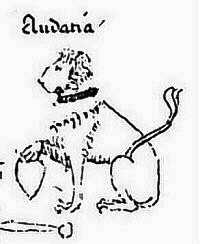
"Piu de mi lione non porta cor ardito
Pero de bataia faço a zaschaduno inuito
Audatia."
"None can bring a more daring heart than me, a lion
And I challenge anyone to battle.
Courage."
The animal figure to the left of the figure of the man is illustrated as a lion, The audacity of a fighter must be tempered with the other attributes, which is perhaps one of the reasons the lion is illustrated on the left side (a secondary place) of the figure of the man as opposed to the right side (a primary place). The right arm is the fighter's primary vehicle for delivering blows is heavily influenced by his/her desire to be victorious, however, is tempered by the lynx's desire for prudence and measure, balanced with the lion's audacity or courage (the desire to be victorious at any cost). Courage is necessary, but courage (audacity) without the other three attributes will create a reckless fighter and would certainly result in the demise of the fighter.
The lion is illustrated supporting a heart with its right paw, which implies that the fighter must also fight with the necessary intensity (heart) in order to be victorious. Therefore, along with the audacity of the lion, the intent represented by the heart, tempered with the attributes of prudence and judgment, creates a fighter with the right combination resulting in a confidence perceived by the opponent creating an advantage for the fighter.
In addition to the interpretations above, the lion illustrated on the left side of the figure of the man, supporting a heart with his right paw, may imply that when the fighter comes to grips with his/her opponent, this situation requires great confidence and courage (heart). The left hand, despite not holding a weapon, is referred to as "a friend", important when actively deployed in close-quarters combat - a theme raised with regularity in Liberi's manuscript.
The lion figures prominently through the ages, especially in the area of heraldry, often included in heraldic designs of coats of arms, representing the attributes of one who is noble, brave and fierce.
The Elephant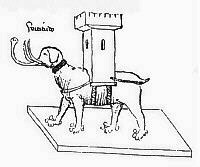
Fortitudo
"Ellefant son e uno castello ho per cargho
E non me inçenochio ni perdo uargho."
Strength
"I am the elephant and I have a castle for a burden
And never do I kneel down nor do I lose my true place."
The figure of an elephant illustrated with a tower on its back is positioned below the figure of the man. Note that the elephant is illustrated without knee joints which come into play later in the examination. The text refers to a "castle", however, the illustration represents only a tower, which was the structure employed as the castle's principle offensive and defensive
The figure of an elephant, coupled with the text highlights an important attribute of a fighter that is strength, a foundation on which the fighter builds skill and technique upon. This is referred to periodically in Liberi's manuscript, and is highlighted in his "abrazare" section as one of the seven important requirements of grappling. Strength when balanced with prudence and judgment, will determine the degree of strength required during an engagement, whereby, should the situation require strength based on the judgment of the fighter, strength is applied. However, if judgment dictates that strength is not required in a situation, then strength should not be applied leveraging other elements to deal with the situation. The application of strength comes into play in a variety of situations, such as powering through a defensive cut, or leveraging strength in close-quarters combat. Unbalanced with the other master attributes, the fighter would position him/herself in a disadvantageous situation, whereby, strength is not the only tool required.
By virtue of the joint less elephant and the tower on its back, implies that the preferred manner of fighting is upright, suggesting that ground fighting is not desirable place to be. The illustration suggests the critical need for proper footwork, ensuring the balance/equilibrium is maintained by the fighter in all situations, otherwise, the fighter may fall (the tower on its back is no longer upright) resulting in an incapacitated fighter. The lack of knee joints in the elephant implies that once down, it would be very difficult to restore to the upright the elephant with its tower returning to a vertical orientation suggesting that going to the ground is detrimental to the fighter. Liberi does not promote ground fighting in his manuscript, and prefers to remain upright, a theme that is consistent throughout the manuscript.
In historical representations of the elephant, rarely is the elephant depicted without a castle or tower on its back. This perception of the elephant and castle may be sourced from the Persian and Indian employment of elephants in war in which they would build offensive structures on the backs of elephants from which they would stage their attack on their enemies.
The Tiger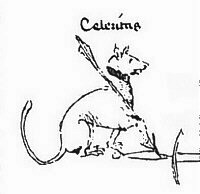
Celeritas
"Yo tigro tanto son presto a corer e uoltare
Che la sagita del cello non me po auancare."
Swiftness
"I am the tiger, I am very quick to run and turn
That the arrow in the sky cannot overcome me."
The last animal figure is the tiger. In the period, tigers were illustrated in two manners, the heraldic tiger and the Bengal tiger. It is apparent that the tiger was unknown to Liberi, and that it was depicted as his "idea" of a tiger and therefore, more closely resembles the heraldic tigers occasionally depicted in heraldic arms.
It is depicted sitting similarly to the lion, and grasping an arrow in its right leg and paw. The tiger typically represented the attributes of speed and strength, with speed being the principle trait highlighted. The relationship between the tiger and arrow is fascinating because in the language of the Medes and Persians the word for arrow was "tigris".
The attribute of speed or swiftness figures highly in the manuscript in the "abrazare" section in which speed and strength are referred to as the top two of the seven important requirements for wrestling. Liberi's presentation of the plays, in all sections of the manuscript often implies speed in two forms, the physical speed in terms of the swiftness of the execution of technique, and the intellectual speed in terms of assessing a particular state of the engagement, and swiftly adapting to the situation and deploy an appropriate response to a changing situation. It is evident in the plays and their order, along with the presentation of counters and counter-counters, that should an anticipated execution not be successful, that there are alternatives to consider and being able to select the most appropriate alternative quickly is appropriately represented by the tiger.
Conclusion
Maestro Fiore dei Liberi, a swordsmaster, born approximately in 1350 in Cividale d'Austria (north-eastern Italy) in a region known as Friuli, had traveled Europe as a young man, and received training by Europe's then swordsmasters from various regions, including Germany. For almost a 1/2 century, he had developed his fighting skills through training with masters, and the application of these skills to numerous battles and duels, in particular, in the Udine area, and later achieving visible recognition of his skills to the point of being commissioned by the Marquis of Ferrara to write a manuscript in order to train fighting men in the upper echelons of society in the early 15th century. It is clear, within the context of the psyche of the medieval period, animals (bestiary) had an obvious indelible impression on their minds, evident not only in this treatise, but the many fabulous writings and books created during this period. It is also clear that the art is highly sophisticated and eloquent, which is counter to the conventional public opinion today.
Bibliography
- Fiore dei Liberi, 1410. Flos Duellatorum
- University of Aberdeen. The Aberdeen Bestiary
- David Badke, 2004. The Medieval Bestiary
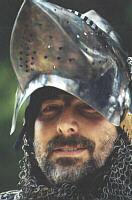 About the author: is the Founder and President of the Academy of European Medieval Martial Arts (AEMMA), an organization dedicated to the resurrection and formalization of medieval martial arts training systems. He received training in Milan, Italy employing steel weapons in longsword techniques and has participated in various organizations dedicated to studying the Middle Ages. His background and experience having fired his desire to pursue a formal medieval martial arts training program, he founded AEMMA in mid-1998. He is a member of the advisory board of the Swordplay Symposium International (SSI), an interdisciplinary colloquium of historical fencing specialists dedicated to promoting and advancing the study of Western swordsmanship, and participating board member of the Association for Historical Fencing (AHF). David received his appointment of free scholler in Oct, 2000 and the "Acknowledged Instructor" (AI) designation for armoured combat instruction in Oct, 2000 by the International Masters at Arms Federation (IMAF).
About the author: is the Founder and President of the Academy of European Medieval Martial Arts (AEMMA), an organization dedicated to the resurrection and formalization of medieval martial arts training systems. He received training in Milan, Italy employing steel weapons in longsword techniques and has participated in various organizations dedicated to studying the Middle Ages. His background and experience having fired his desire to pursue a formal medieval martial arts training program, he founded AEMMA in mid-1998. He is a member of the advisory board of the Swordplay Symposium International (SSI), an interdisciplinary colloquium of historical fencing specialists dedicated to promoting and advancing the study of Western swordsmanship, and participating board member of the Association for Historical Fencing (AHF). David received his appointment of free scholler in Oct, 2000 and the "Acknowledged Instructor" (AI) designation for armoured combat instruction in Oct, 2000 by the International Masters at Arms Federation (IMAF).
Journal of Western Martial Art
January 2005
EJMAS Copyright © 2005 All Rights Reserved